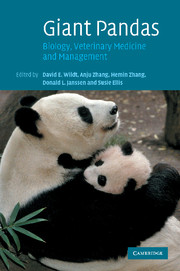Book contents
- Frontmatter
- Contents
- List of contributors
- Foreword
- Acknowledgements
- 1 The giant panda as a social, biological and conservation phenomenon
- 2 The Giant Panda Biomedical Survey: how it began and the value of people working together across cultures and disciplines
- 3 Factors limiting reproductive success in the giant panda as revealed by a Biomedical Survey
- 4 Significant medical issues and biological reference values for giant pandas from the Biomedical Survey
- 5 Life histories and behavioural traits as predictors of breeding status
- 6 Nutrition and dietary husbandry
- 7 Male reproductive biology in giant pandas in breeding programmes in China
- 8 Endocrinology of the giant panda and application of hormone technology to species management
- 9 The value and significance of vaginal cytology
- 10 Parentage assessment among captive giant pandas in China
- 11 The science of behavioural management: creating biologically relevant living environments in captivity
- 12 Evaluating stress and well-being in the giant panda: a system for monitoring
- 13 The neonatal giant panda: hand-rearing and medical management
- 14 Consequences of early rearing on socialization and social competence of the giant panda
- 15 Medical management of captive adult and geriatric giant pandas
- 16 Diseases and pathology of giant pandas
- 17 Ultrasonography to assess and enhance health and reproduction in the giant panda
- 18 Gastrointestinal endoscopy in the giant panda
- 19 Historical perspective of breeding giant pandas ex situ in China and high priorities for the future
- 20 Role and efficiency of artificial insemination and genome resource banking
- 21 Analysis of demographic and genetic trends for developing a captive breeding masterplan for the giant panda
- 22 Partnerships and capacity building for securing giant pandas ex situ and in situ: how zoos are contributing to conservation
- Index
- Plate Section
- References
18 - Gastrointestinal endoscopy in the giant panda
Published online by Cambridge University Press: 09 August 2009
- Frontmatter
- Contents
- List of contributors
- Foreword
- Acknowledgements
- 1 The giant panda as a social, biological and conservation phenomenon
- 2 The Giant Panda Biomedical Survey: how it began and the value of people working together across cultures and disciplines
- 3 Factors limiting reproductive success in the giant panda as revealed by a Biomedical Survey
- 4 Significant medical issues and biological reference values for giant pandas from the Biomedical Survey
- 5 Life histories and behavioural traits as predictors of breeding status
- 6 Nutrition and dietary husbandry
- 7 Male reproductive biology in giant pandas in breeding programmes in China
- 8 Endocrinology of the giant panda and application of hormone technology to species management
- 9 The value and significance of vaginal cytology
- 10 Parentage assessment among captive giant pandas in China
- 11 The science of behavioural management: creating biologically relevant living environments in captivity
- 12 Evaluating stress and well-being in the giant panda: a system for monitoring
- 13 The neonatal giant panda: hand-rearing and medical management
- 14 Consequences of early rearing on socialization and social competence of the giant panda
- 15 Medical management of captive adult and geriatric giant pandas
- 16 Diseases and pathology of giant pandas
- 17 Ultrasonography to assess and enhance health and reproduction in the giant panda
- 18 Gastrointestinal endoscopy in the giant panda
- 19 Historical perspective of breeding giant pandas ex situ in China and high priorities for the future
- 20 Role and efficiency of artificial insemination and genome resource banking
- 21 Analysis of demographic and genetic trends for developing a captive breeding masterplan for the giant panda
- 22 Partnerships and capacity building for securing giant pandas ex situ and in situ: how zoos are contributing to conservation
- Index
- Plate Section
- References
Summary
INTRODUCTION
Endoscopy is a minimally invasive method of evaluating the gross appearance of the mucosal surfaces of the gastrointestinal, respiratory and urogenital tracts (Guilford, 1996). Efficient methods of performing endoscopic evaluation of these systems have been developed in small and large animal medicine (Jones, 1997). Besides providing direct visualisation, endoscopy permits obtaining representative biopsy specimens for subsequent histopathological tissue assessments. Video endoscopy allows recorded observations (for retrospective evaluation) as well as group participation by investigators and students, thereby improving both diagnostics and training opportunities.
The original CBSG Biomedical Survey of the giant panda made minimal use of endoscopy, although laparoscopy was used in a few individuals and found to be effective for evaluating abdominal organs, including the uterine cornuae and all ovarian surfaces (see Chapter 4). Other medical findings from this initial survey suggested the need to test other forms of endoscopy for more advanced diagnostic evaluations. Thus the present study was conducted in 2004 at the invitation of the Chengdu Research Base of Giant Panda Breeding. It was a component of a more thorough set of evaluative procedures that included case histories, physical examinations, haematology, blood chemistry, ultrasonography, serology, toxicology, histopathology and faecal analysis of 11 giant pandas. The subject of this chapter exclusively involves the effectiveness of using endoscopy at this same time to examine the gastrointestinal tract of this species.
- Type
- Chapter
- Information
- Giant PandasBiology, Veterinary Medicine and Management, pp. 440 - 454Publisher: Cambridge University PressPrint publication year: 2006

